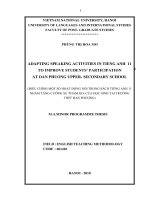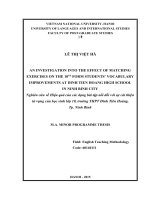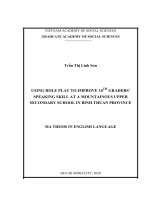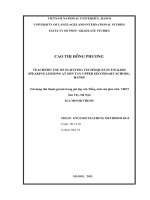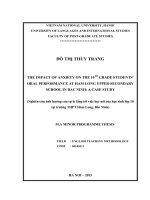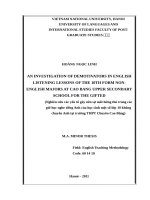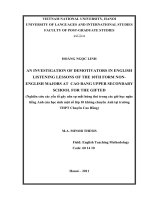Adapting speaking tasks in the text book tieng anh 11 to improve the 11th form students speaking achievement at dai mo upper secondary school
Bạn đang xem bản rút gọn của tài liệu. Xem và tải ngay bản đầy đủ của tài liệu tại đây (3.04 MB, 90 trang )
Vietnam National University, Hanoi
University of Languages and International Studies
Faculty of post- graduate studies
*****
HÁN THỊ VĨNH HÀ
Adapting speaking tasks in the text book Tieng Anh 11 to
improve the 11th form students’ speaking achievement at Dai
Mo upper-secondary school
Điều chỉnh các nhiệm vụ nói trong sách giáo khoa Tiếng Anh 11 nhằm
nâng cao khả năng nói cho học sinh lớp 11 trường THPT Đại Mỗ
M.A MINOR PROGRAMME THESIS
Field: Methodology
HA NOI, 2014
Vietnam National University, Hanoi
University of Languages and International studies
Faculty of post- graduate studies
*****
HÁN THỊ VĨNH HÀ
Adapting speaking tasks in the text book Tieng Anh 11 to
improve the 11th form students’ speaking achievement at Dai
Mo upper-secondary school
Điều chỉnh các nhiệm vụ nói trong sách giáo khoa Tiếng Anh 11 nhằm
nâng cao khả năng nói cho học sinh lớp 11 trường THPT Đại Mỗ
M.A MINOR PROGRAMME THESIS
Field: Methodology
Supervisor: Assoc. Prof., PhD. Nguyễn Văn Độ
HA NOI, 2014
i
DECLARATION
I hereby certify the thesis entitled “Adapting speaking tasks in the text book Tieng Anh 11
to improve the 11th form students’ speaking achievement at Dai Mo upper-secondary school” is
my own study in the fulfillment of the requirements for the Degree of Master of Arts at
University of Languages and International Studies, Vietnam National University, Hanoi.
Signature
Hán Thị Vĩnh Hà
ii
ACKNOWLEDGEMENTS
I have benefited a great deal of support from a number of people during the time carrying
out this thesis.
I would like first and foremost to express my profound gratitude and appreciation to my
supervisor, Dr. Prof. Nguyễn Văn Độ for his invaluable and insightful comments, his deliberate
guidance and wholehearted supervision without which the thesis would not have been possible.
My thanks are offered to all my respected lecturers in the M.A course, Assoc. Prof. Dr Lê
Hùng Tiến, Prof. Dr. Nguyễn Quang, Dr. Lê Văn Canh, Dr. Kiều Thị Thu Hương, Dr, Lâm
Quang Đông…., for their informative and valuable lectures that have enlightened my research
path of the study. I also take this opportunity to express my gratefulness to the administrative
staff of the Department of Post Graduate Studies, CFL,VNU-Hanoi, for their help, guidance and
support.
Special acknowledgement is also given to my students from classes 11A1 Dai Mo upper-
secondary school for their participation in the lessons. My appreciation is also extended to my
colleagues in the English division of Dai Mo upper-secondary school for their assistance and
work sharing so that I could concentrate on doing the research.
Last but not least, my heartfelt thanks go to my family and my close friends for their
understanding, love, and support during the entire period of my study.
iii
ABSTRACT
In the teaching context of Dai Mo upper-secondary school in Nam Tu Liem, Ha Noi, the
adaptation of speaking tasks in the textbook Tieng Anh 11 is necessary because teaching and
learning speaking is not usually efficient. The students could hardly take part in speaking tasks
seriously because they had difficulty expressing their ideas though they have the desire to speak
English. This mini action research was conducted in order to investigate how adapted tasks
helped students of low level to get more involved in speaking, as well as improve their language
accuracy, fluency and complexity. Oral tests together with survey questionnaire and observations
was the main instrument of data collection. They were delivered to 40 grade-11 students to
collect individual scores before and after each of the two cycles, their opinions about speaking
tasks in the textbook and their behaviors while doing speaking tasks. Based on the data, the
speaking tasks were adapted and speaking activities were implemented then pilot teaching was
employed to check their effectiveness. The results indicated that most of the adapted tasks
resulted in some clear improvement in the students’ participation and their language proficiency
without omitting available textbook tasks or overloaded supplemented materials. Finally, some
suggestions and implications for teaching speaking, task adaptation were offered to support
students’ speaking skills at Dai Mo upper-secondary school.
iv
LIST OF FIGURES AND TABLES
Table 1: The students’ motivation in learning English speaking
Table 2+3: The students’ opinions about English speaking skills in the textbook Tieng Anh 11
Table 4: The students’ general evaluation of their current speaking lessons
Table 5: The students’ participation in speaking lessons.
Table 6: Factors prevent the students from participating in speaking in the class.
Table 7: The students’ opinion about the way their teacher taught English speaking
Table 8: The students’ evaluation of their teacher’s task adaptation
Table 9: The students’ scores in the Pre-test.
Table 10: The students’ opinions about the vocabulary relating to the topics in the speaking tasks
Table 11+12: The students’ opinions about the topics of speaking tasks
Table 13+14: The students’ opinions about the speaking tasks
Table 15: The students’ response to the adapted tasks for Unit 15
Table 16: The students’ response to the adapted tasks for Unit 16
Table 17: The students’ scores in Post-test in cycle 1.
Table 18: The students’ scores in Post-test in cycle 2.
Figure 1: The students’ motivation in learning English speaking
Figure 2: The students’ opinions about the textbook’s topics in the textbook Tieng Anh 11
Figure 3: The students’ opinions about the textbook’s speaking activities in the textbook Tieng
Anh 11
Figure 4: The students’ general evaluation of their current speaking lessons
Figure 5: The students’ participation in speaking lessons.
Figure 6: : Factors prevented the students from participating in speaking in the class.
Figure 7: The students’ opinion about the way their teachers taught speaking
v
Figure 8: The students’ evaluation of their teacher’s adaptation
Figure 9: The students’ scores in the Pre-test.
Figure 10: The students’ opinions about the vocabulary relating to the topics in the speaking tasks
Figure 11: The students’ opinions about the topic’s familiarity of the speaking tasks
Figure 13: The students’ opinions about the speaking tasks’ ease
Figure 14: The students’ opinions about the speaking tasks’ interesting organization
Figure 15: The students’ response to the adapted tasks for Unit 15
Figure 16: The students’ response to the adapted tasks for Unit 16
Figure 17: The students’ scores in the Post-test in cycle 1
Figure 18: The students’ scores in the Post-test in cycle 2
vi
TABLE OF CONTENTS
1
PART I: INTRODUCTION
1. Rationale for the study
In the past ten years, teaching English speaking at school has earned a lot of attention and
investment from both experts and teachers as well as learners and their communities. The three
main reasons must be: first, the key practical role of English speaking has received the social
awareness; second, tape-recording and the Internet has enabled learners to access to native
speakers’ talks; third, many methodology courses sponsored by the government have helped
teachers to approach some new teaching methods. As a result, students’ speaking ability has
improved much in general.
Despite all of the above advantages, I see no much progress in the case of Dai Mo upper-
secondary school, class 11A1 in particular. By observing, I notice most of the students hesitate to
participate in English speaking tasks. Even as the teachers have managed to engage them in, their
talks show some problems of using accurate, fluent and complex language.
Some researchers have been particularly interested in the same situation in teaching
English skills and tried to improve it by adaptation (Phùng Thị Hoa Mơ, 2010; Nguyễn Thị
Trang, 2012). However, most of them concluded that poor textbooks and students’ low
motivation were the main reasons. Whereas the students in class 11A1 confirmed that they
wanted to speak English much more than reading, writing, grammar, and they found almost all
the topics interesting. Especially, to grant comparatively equal achievements among students
from different schools, a set of compulsory textbooks have been published. The textbooks have
several strong points, that is task-based contexts are available and communication practice is
carefully guided.
Considering their English scores at the beginning of the course, I realized that most of
them were of low level, some were better but no one was advanced. Therefore, I did a
preliminary research, searched the Internet and read ESL/EFL studies. I found that spoken
discourse has its own characteristics and, thus, the teaching must be distinctive. I wondered if I
could help them by providing them with more language input together with knowledge
background, and by adapting some speaking tasks in the textbook Tiếng Anh 11. I did hope that
these changes would help them to have such achievements as participating more in speaking
activities and producing somewhat more accurate, fluent and complex language.
2
All of these above have inspired me to conduct the study titled “Adapting speaking tasks
in the text book Tieng Anh 11 to improve the 11th form students’ speaking achievement at Dai
Mo upper-secondary school.”
2. Aims of the study
The study was designed to help the students of low levels in class 11A1 to participate
more in speaking activities and produce more accurate, fluent and complex language through the
adaptation of the textbook Tieng Anh 11.
The study is aimed:
1. To investigate the reasons why the English teacher at Dai Mo high school should adapt
speaking activities in Tieng Anh 11
2. To find out approaches to adapt speaking tasks in the textbook Tieng Anh
11 for low-level students.
3. To investigate whether the adaptation increases the students’ participation and
improves their accurate, fluent and complex language.
3. Research questions
In order to achieve the mentioned aims, the following research questions guided the
study:
1. Why should teachers in Dai Mo upper-secondary adapt speaking activities in the
textbook Tieng Anh 11?
2. In what ways can tasks be adapted to help the students improve their speaking skill?
3. Does the adaptation increase the students’ participation and improve their accurate,
fluent and complex language?
4. Scope of the study
Materials adaptation is such a broad topic that it cannot be wholly discussed within the
framework of this paper; therefore, only one specific aspect will be central to the speaking tasks’
adaptation.
With the focus on speaking tasks in the textbook Tieng Anh 11 (the basic textbook), the
study was carried out to adapt those for the students of low levels.
3
The study focuses on one class of grade-11 students, so the results of the study are not
applied for all students at Dai Mo upper-secondary school.
5. Methods of the study
The study in fact is a mini action research. According to Nunan (1992: 19), an action
research includes seven steps. They are: initiation, preliminary investigation, hypothesis,
intervention, evaluation, dissemination and follow-up. The applied steps in details are as follows:
Step 1- Initiation: In the process of teaching the textbook Tieng Anh 11, I observed that
most of the students hesitated to participate in speaking tasks. Even as the teachers had managed
to engage them in, their talks showed some problems of using accurate, fluent and complex
language. The students confirmed that they want to speak English much more than reading,
writing, grammar, and they found almost all the topics interesting, though. What should be done?
Step 2- Preliminary investigation: I carried out the preliminary survey and did some
initial observations to find out how speaking tasks were managed, how often they took part in
speaking activities and how the language produced was. Also, I searched the Internet and read
academic studies on ESL and EFL.
Step 3- Hypothesis: By collecting and reviewing the baseline data, I came to the
hypothesis that the students’ speaking achievement was not high because they often encountered
problems associated with language and background knowledge due to their low English
speaking levels; and that the adaptation of some speaking tasks by ‘making accuracy-based
practice meaningful’ and ‘adapting fluency-based activities’ can help them improve their
participation, language accuracy and fluency.
Step 4- Intervention: My research had two circles.
First, the students were asked to take an oral test. The students’ scores were counted into
percentages by following students’ score intervals.
Second, I conducted Cycle 1: Before the new speaking lesson, I asked the students to
answer some questions to find out their opinions about the topic and speaking tasks in the coming
lesson. After collecting the results, the adapted tasks were delivered. I observed the class and
took notes the teaching-learning activities and the students’ behaviors. When the students
finished the tasks, I provided them with survey questionnaires for response to the adaptation.
Then, an oral test was delivered to the students. Data analysis, reflection and comparison were
4
done to investigate the students’ speaking improvement in terms of participation, language
accuracy and fluency.
Because the successful result was not reached yet, it was needed to do another cycle.
Final, Cycle 2 was conducted with the same procedure as that of cycle 1.
Though the students’ speaking achievement was not improved to advanced level, it was
accepted in this case. Therefore, no more cycle was conducted.
Step 5- Evaluation:
Before adaptation, the students’ scores showed their low speaking achievement because
of such problems as they did not have enough vocabulary, feeling shy when they spoke in front
of others, they were still rigid to express their ideas.
After circle 1, the students found the adapted tasks less challenging and achievable. They
responded in English more freely, had the feelings of being understood and took part in speaking
lessons more actively. However, the complexity of the language had not been achieved yet.
After circle 2, the students felt more confident in controlling their English language while
speaking. They verified expressions, which were exchanged among partners. Though this
improvement was considerable and valuable, it did not reach the goal of producing their own
language.
Step 6- Dissemination: I discussed the effectiveness of the adapted tasks to the students
and colleagues.
Step 7- Follow-up: I suggested some more adapted activities to teach other speaking
lessons basing on the textbook Tieng Anh 11 to the students.
6. Design of the study
The study titled “Adapting speaking tasks in the text book Tieng Anh 11 to improve the
11th form students’ speaking achievement at Dai Mo upper-secondary school.”/consists of three
main parts namely Introduction, Development and Conclusion.
In the first part, Introduction, the reasons for the research, aims, research questions, scope
and methods of the study are mentioned.
The second part, Development, contains four chapters.
5
- Chapter One focuses on theoretical background of the study, which is about
features, and functions of spoken discourse, implications for teaching, and purposes as
well as two main approaches of adaptations: accuracy-based practice and fluency-based
activities.
- Chapter Two not only describes the context of teaching and learning English at
Dai Mo upper-secondary school but also presents the instrumentation of the study, the
adaptation of speaking tasks.
- Chapter Three deals with a comprehensive data analysis.
The last part, Conclusion, provides major findings, discussion, limitations and
recommendations for follow-up action.
6
PART II: DEVELOPMENT
CHAPTER 1. LITERATURE REVIEW
1. An overview on the teaching of speaking
In order to help students to develop their English speaking ability we need insights about
the nature of spoken discourse, so we will be able to find a useful methodology to select and
design appropriate classroom activities.
1.1. The speaking
1.1.1. The role of spoken English
The mastery of English speaking skills plays a very important role for many foreign
language learners. Consequently, learners tend to evaluate their success in language learning as
well as the effectiveness of their English lessons basing on how well they feel they have
improved in their speaking ability or proficiency.
In addition, teachers and textbooks make use of a variety of approaches in the teaching of
oral skills, which shows that “ oral skills have hardly been neglected in EFL/ESL courses” .
Therefore, it is observed that “ how best to approach the teaching of oral skills has long been the
focus of methodological debate”, Richards (2009:21).
Reflecting on the textbook Tieng Anh 11, I think teacher can take a great deal of
advantages in methodology.
1.1.2. Nature of spoken discourse
According to McCarthy and Carter, 1997 (cited in Richards, 2009:21), it is recent
advances in discourse analysis that have revealed the nature of spoken discourse and its
differences from written discourse. Luoma, 2004 (cited in Richards, 2009:22) points out some of
the following features of spoken discourse:
Conjoined short phrases and clauses
May be planned or unplanned
Employs more vague or generic words than written language
Employs fixed phrases, fillers and hesitation markers
Contains slips and errors reflecting on-line processing
7
Interactions are jointly constructed
Shows variation, reflecting speaker roles, speaking purpose, and the context
Among them, I pay much attention to the two following features:
First, “spoken discourse is usually unplanned and often reflects the processes of
constructions”, Richards (2009:2). Thus, errors must be carefully chosen to be treated in order
that the correction does not ruin fluency. In my opinion, errors that impede communication
should be directly corrected. Tricia Hedge (2000:289) gives an example of such error: “ They ate
smoked worm” is not immediately apparent as “They ate smoked eel”, and “long trees” can be
misunderstood as “tall trees”. Besides, the assessment of fluency should be much more flexible,
which will be discussed in detail in the part of adaptation.
Second, “interactions are jointly constructed”, which asks for shared background, active
and intelligibility participation. It implies that in addition to fluency, accuracy must be put in
consideration and speaking activities must be well designed so that engaging students in can be
successful. Moreover, the topic of speaking tasks in textbooks should be familiar to students, or
else some preparation must be made before each lesson.
1.1.3. Functions of speaking
Richards uses a three-part framework, which is expanded from Brown and Yule’s one, to
classify the interaction functions of speaking: talk as interaction, talk as transaction, and talk as
performance. Their forms and functions are quite different and therefore they require different
teaching approaches.
a. Talk as interaction
This refers to “conversation” which serves as primarily social function. The focus is more
on speaker’s wish to present themselves other than on the message. Brown and Yule, 1983 (cited
in Richards, 2009:25) describe its main features as follows:
Has a primarily social function
Is jointly constructed
b. Talk as transaction
The focus of this kind of talk is on what is said or done. The message and making oneself
understood clearly and accurately are focused on rather than the participants and their interacting
manner.
8
Some main features are given by Richards (2009:29):
It has a primarily information focus
Linguistic accuracy is not always important
c. Talk as performance
This type of talk refers to public talk transmitting information in front of an audience.
According to Richards (2009:32), the main features of talks as performance are:
It reflects predictable organization and sequencing
Form and accuracy is important
1.1.4. Implications for teaching
a. Talk as interaction
Though mastering such skills is difficult and may not be the most important to most
students at school, I think they should practice a wide range of topics to present good images of
themselves in situations which call for interaction talks.
Two simple activities Richards use to practice topic management are “in the hot seat” and
“question time”. In the first activity, a student sits on a chair in front of the class and makes a
statement about something he or she did recently. The other members of the class have to ask
three or more questions about the topic which the student has to answer quickly. Then another
student takes the hot seat. With the activity called question time, before students begin a lesson
on a new theme, he prepares up to 15 questions related to the theme and put them on a handout.
First, he asks students around the class to answer the questions quickly. Then students practice
asking and answering the questions in pairs.
b. Talk as transaction
In terms of the level of linguistic accuracy that students achieve when carrying out tasks
as transaction, some scholars like Thornbury,1998 and Kumaravadivelu,1991 state that practicing
these tasks focuses on task accomplishment rather than grammatical practice and a gradual
modification of their language output over time takes on more and more target-like forms.
However, Higgs and Clifford, 1982 (cited in Richards 2009:37) claim that communication tasks
often develop fluency at the expense of accuracy. Richards (2009:39) recognizes that low-level
students often heavily rely on vocabulary and memorized chunks of language while carrying out
9
communication tasks. Therefore, to improve the quality (accuracy and fluency) of language
produced as students practice, he suggests:
Pre-teaching certain linguistic forms
Reducing the complexity of the task
Giving time to plan the task
Repeating performance of the task
c. Talk as performance
According to Johns,1996 (cited in Richards, 2009:42), teaching this type of talk requires a
different teaching strategy which involves providing examples or models of speeches, oral
presentation, stories,etc through video or audio recordings or written examples. Guiding
questions are:
What is the speaker’s purpose?
Who is the audience?
What kind of information does the audience expect?
How does the talk begin, develop, and end? What moves or stages are involved?
Is any special language used?
1.2. Factors affecting students’ speaking
Students’ participation in classroom speaking activities and their English output can be
affected by a variety of factors originating from context, learners, teachers, materials and
classroom activities. In the following sections, some of the major factors will be discussed.
1.2.1. Factors of context
Most of factors are “ outside the teacher’s control but they will bear heavily on decisions
about choice of resources and classroom procedure” (Hedge, 2000:24). She mentions the
following factors:
Social attitudes
Social attitudes towards English learning partly determine teachers’ effort to motivate
students and exposure to the language as well.
Educational system
Whether educational system provides potential or constraint depends on:
10
- The extent to which the materials in use train for public examinations
- The hours available for teaching
- The existence of institutional or departmental policies
- The physical constraints of the classroom
- Class size
- The resources available
- The cohesion that exists among English language teachers
- The status of teachers in the hierarchy
- The financial/contractual status of teachers
- The interest of management in continuing professional development
Examination system
Examination system is a heavily constraining factor where examinations are considered
gatekeepers to higher education or good jobs. Teachers would be of high risk not to train students
for these.
1.2.2. Factors of teachers
Harmer, 1991 (cited in Hedge, 2000:26) identify teachers’ roles “as controller in eliciting
nationality words; as assessor of accuracy; as corrector of pronunciation; as organizer in giving
instructions for the pair work, initiating it, monitoring it, and organizing feedback; as prompter
while students are working together; and as resource if students need help”. All of these are
common to a wide range of classroom methods. Hedge (2000: 22-31) says that they can be seen
in lesson plans but only can the ability to manage activities and interactions put them in practice.
Only when teachers have competence in management of interaction can the mentioned roles
create beneficial conditions for language learning.
1.2.3. Factors of learners
Individual differences exist and play a significant role in language learning. However,
they are just the useful distinctions to classify them in order to have some possible implications
for teaching. Because there are not “certain attitudes, personality characteristics, emotional
disposition, and learning strategies that somehow create the generically ‘good language learner’”
(Hedge, 2000:24).
Addition to individual differences, students in Dai Mo upper-secondary school share some
common characteristics that affect their learning in general and speaking in particular. They are
11
of low-level, which leads to limitations in language output (accuracy, fluency and complexity)
and anxiety (participation).
1.2.4. Factors of materials
O’Neill, 1982 (cited in Hedge, 2000:36) outlines the benefits of textbook materials: “they
can offer a grammatical and functional framework which provides for the common needs of a
group of learners; they allow students to prepare in advance; they provide quality of presentation,
and they do not necessarily prevent a creative spinning-off in the classroom into all kinds of other
activities.” Nevertheless, because of all the factors of teachers and learners mentioned above,
textbooks should be learning guides for students, and “good teachers have always taken a
positively critical approach to appraising and developing their work”.
2. Tasks and task adaptation
No course book will be total suited to a particular teaching situation. The teacher will
have to find his own way of using it and adapting it if necessary. So we should not be looking for
the perfect course book which meets all our requirement, but rather for the best possible fit
between what the course book offers and what we as teachers and students need. Two
approaches that guided this research were making accuracy-based practice meaningful and
adapting fluency-based activities
2.1. Tasks in FL/SL learning and teaching
Many linguists argue whether tasks can involve learners in working with particular kinds
of language. Brumfit, 1984a (cited in Carter and Nunan, 2001:19) stresses that students should be
provided the freedom to improve in fluency activities. Skehan, 1998 (cited in Carter and Nunan,
2001:19) believes that tasks can only provide conditions for influencing the level of learners’
complexity, accuracy or fluency. In contrast, Loschky and Bley-Vroman, 1993 (cited in Carter
and Nunan, 2001:19) argue that tasks can target language features. Therefore, Carter and Nunan
(2001:19) state that the key question is how tasks operate and how to make tasks operate
effectively within classroom contexts.
2.2. Task adaptation in FL/SL learning and teaching
2.2.1. The need of task adaptation
No certain set of activities can ensure that different groups of students practice the
speaking and problems can be found around the activities. Hedge (2000:281-283) believes that
12
whenever a problem occurs, which leads to students’ failure, they can feel frustrated to perform
and they do not behave in them as the activities suggest they should. This usually obstacles the
possible contributions to speaking activities and presents limitations to the development of
English speaking ability. It suggests to us the need to create range and variety in language
activities to adapt to the teaching and learning context.
2.2.2. What is adaptation?
According to Tomlinson (1998: xi), adaptation is “making changes to materials in order to
improve them more suitable for a particular type of learner.” In the aspect of adaptation
techniques, Madsen and Bowen (1978: ix-xi) mentions adaptation as the action of employing
“one or more of a number of techniques: supplementing, editing, expanding, personalizing,
simplifying, modernizing, localizing, or modifying cultural/ situational content.” Differently,
Stevick (1972), cited in Mc Donough and Shaw (1993: 83) emphasizes teachers’ role of bridging
a gap between materials and learners: “the teacher must satisfy the demand of the textbook, but in
ways that will be satisfying to those who learn from it.”
In brief, adaptation requires teachers to change and revise materials to make them more
accessible to the teaching context.
2.2.3. The purpose of adaptation
There are always some practical reasons for adapting materials in order to make
them as accessible and useful to learners as possible. However, reasons for adaptation have
varied and changed as the field has developed and views on language acquisition and teaching
practice have become better informed by research and experience. There are two most frequently
cited purposes for adaptation:
to make the material more suitable for the circumstances in which it is being used, i.e. to
mould it to the needs and interests of learners, the teachers’ own capabilities and such constraints
as time, or as Mc Donough and Shaw (1993:85) put it: “to maximize the appropriateness of
teaching materials in context, by changing some of the internal characteristics of a course book to
better suit our particular circumstances”
to compensate for any intrinsic deficiencies in the materials, such as linguistic inaccuracy,
out-of-datedness, lack of authenticity (Madsen and Bowen 1978) or lack of variety.
13
Look deeper into McDonough and Shaw’s definition of purpose we see that maximizing
the appropriateness of teaching materials (by, e.g., modifying them in such a way that they seem
more relevant to learners’ interests and needs) is important because when teachers make changes
to a course book “to better suit our particular purposes” what teachers are really trying to do is to
improve students’ participation to increase the effectiveness of the learning experience.
2.2.4. Approaches to task adaptation
Brumfit, 1984a (cited in Hedge, 2000:283) suggests that beginners “need a strong focus
on learning to use grammar, vocabulary, and features of pronunciation in more controlled,
intensive forms of practice, but that they will then need opportunities to use the resources they
have acquired in fluency work which stimulates real language use.” However, Carter and Nunan
(2001:19) prefer “to engage learners’ fluent processing to begin with and only subsequently lead
them to integrate accurate language features into that fluent ‘base’”.
I myself base on types of activities to decide whether fluency-focus or accuracy-focus.
And I also tend to practice accuracy work within fluency activities; thus, complexity can be
achieved later; because John and Liz Soars in the Introduction to Headway Upper Intermediate
Teacher’s book (page iii), argue that students who have passed through the ‘intermediate stage of
a programme and who have ‘sufficient linguistic confidence an ability to survive in a target
language environment and understand the gist of what is going on around them’ will still have
inaccuracies and a relatively narrow range of vocabulary. Therefore, “maintaining or even
increasing the amount of accuracy work might eliminate some of these mistakes and enrich their
language repertoire” (ibid.).
I believe the two following approaches can produce effective adaptation:
a. Making accuracy-based practice meaningful
Learners in communicative classrooms need to be exposed to input that they can attend to,
and given opportunities to produce output in activities with more control. Controlled activities
may deal with “a grammatical structure, a phonological feature, a conventional gambit, a
communicative function, or the time sequencers that might be needed in telling a story”, all of
which have a conscious focus on language (Hedge, 2000:273).
14
Hedge (2000:273-276) gives two suggestions:
Contextualizing
Contextualized practice “aims to make clear the link between linguistic form and
communicative function”, which “means finding a situation in which a structure is commonly
used.” [ For the example of contextualizing, see appendix 6-1]
Personalizing
Personalizing “the language enables students to express their own ideas, feelings,
preferences, and opinion”, which “makes the language more memorable”. To make it motivating,
students must be allowed to choose what they say in some degree so that they can “make use of
language resources in interpersonal situations”. [ For the example of personalizing, see appendix
6-2]
b. Adapting fluency-based activities
In textbooks, we can see a lot of available fluency-based activities. Making use most of
them and adapting some is what I choose to contribute to the development of students’ speaking
skills.
Hedge (2000:277-281) suggests three basic types of activities used for adaptation:
Free discussion
In free discussion, students can cover a wide range of topics and practice strategies
required in interpersonal communication such as taking and holding turns, encouraging
responses, etc. However, more proficient or more confident students may dominate over anxious
ones, thus participation from all members of the group may not take place.
To overcome this, teachers need to support students with material that can focus the
discussion, provide content and linguistic resources. Reporting stage after taking note the
discussion accurately also makes students follow the arguments. In addition, goals should be
established. Group roles can ensure equality of opportunity for all group members. [ For the
example of group roles, see appendix 6-3]
Role-play
15
Role-play can be an effective “fluency activity if it is performed in pairs or groups rather
than one group acting in front of the class” and it should be based on real-life situations. Thus,
role-play encourages a large number of students to participate in the activity. Another advantage
is that as students take on different roles they will have a chance to practice language that varies
according to the setting. [ For the example of role-play, see appendix 6-4]
‘Gap’ activities
‘Gap’ activity “involves each learner in a pair or group possessing information which
other learners do not have. The learners’ information must be shared in order to achieve an
outcome”. One value of this fluency-based type is that it can push students to more accurate
output while negotiating meaning and adjusting the conversation. [ For the example of ‘gap’
activities, see appendix 6-5]
3. Summary
To conclude, with the awareness of factors affecting students’ participation and language
proficiency together with two main approaches to adaptation, I adapted some activities in Tieng
Anh 11 to make them more communicative, suitable to my students’ ability in class 11A1 at Dai
Mo upper-secondary school. Contextualizing, group roles, role-play and personalizing were
popular adaptation techniques used in the research. Details of these above contents will be
presented in chapter 3 and 4.
16
CHAPTER 2. THE STUDY
Mini Action Research
This chapter will analyze the situation of the study with the description of the subjects, the
materials used by the students, the approaches of adaptations and the instruments applied to
collect data.
1. Situation analysis
1.1. Setting of the study
The study was conducted in class 11A1 at Dai Mo upper-secondary school in Nam Tu
Liem, Hanoi City. At Dai Mo upper-secondary school as well as other secondary schools all over
the country, English is one of the three compulsory core subjects in the national examination for
GCSE (General Certificate of Secondary Education).
The students have three 45-minute periods of English a week, that is, 51 periods in term 1
and 54 periods in term 2. However, there are only seven speaking lessons in each term.
1.2. The learners
The study was carried out with the participation of 40 students of class 11A1. In general,
the students are at the age of 17. There are 16 girls and 24 boys. They all live in Nam Tu Liem
district. All of them have learnt English since they were at grade 3, but most of them are low-
level English speakers. Though they pay much attention to study English, their English is not
very good in general and their speaking ability is of low level in particular.
At the time of the study, the students were in their second term of the school year. The
second term began with Unit 9.
1.3. Speaking materials
The textbook Tieng Anh 11, edited by Prof. Hoang Van Van and written by Hoang Thi
Xuan Hoa, Dao Ngoc Loc, Vu Thi Loi, Do Tuan Minh and Nguyen Quoc Tuan, published by
Nha xuat ban giao duc, is a theme-based textbook, and a continuance of the textbooks Tieng Anh
10 . It is intended to provide students with thorough coverage of basic grammatical and lexical
items and language skills.
17
The textbook is used for grade-11 students. It consists of 16 units. Each unit has one
speaking lesson. All the speaking lessons in the textbook follow three stages of pre-speaking,
while-speaking and post-speaking. The speaking tasks are not too difficult with coherent stages.
They are intended to be suitable for all levels of students. However, they are beyond the students’
level in Dai Mo School.
2. Instrumentation and Procedures
The data collected from student-based evaluation and respond-based evaluation (Ellis,
1997: 39-40) helped conduct this mini action research. The former was to check whether the
speaking tasks are useful, based on the students’ attitudes to the speaking tasks. Thus, the data
was practical and reliable. Doing the later, the teacher had to see the actual outcomes by
examining not only the products but also the processes of the tasks.
Oral tests were utilized as the main data collection instruments, questionnaires and class
observations were functioned as supplementary sources of information. Because the students’
scores were counted into percentages and all the informants answered the same questions, the
data collected were easy to be summarized, analyzed and reported. Furthermore, the subjects
were free to give their ideas without having to provide personal information. For that reason, the
researcher has more uniform and accurate data.
To avoid misunderstanding and ensure the accuracy of the data, both types of
questionnaires were written in Vietnamese and distributed with the researcher’s clear
explanation.
The researcher let the participants read the tasks before hand and let them respond to a
survey questionnaire one period before each reading lesson, and set aside 15 minutes after each
speaking lesson so that they were not under pressure of time.
The instruments and procedures used to gather the information for the study will be
described as follows:
2.1. Instrument 1: Preliminary Survey
The Preliminary Survey Questionnaire (see Appendix 1) was delivered to the students at
the beginning of the second term, after they have finished the first term. It was designed with four
parts. Part 1 with 3 questions seeks information about students’ sex, time of learning English and
English result of the previous semester. The questions in part two was designed to find the
